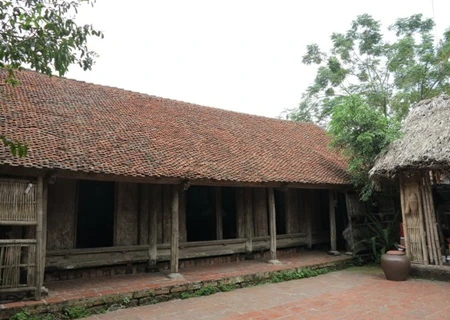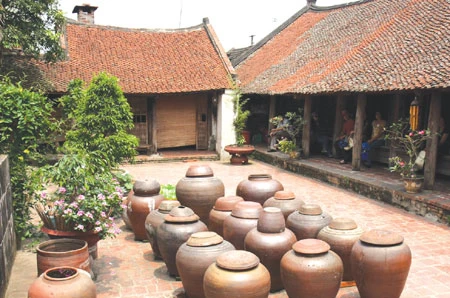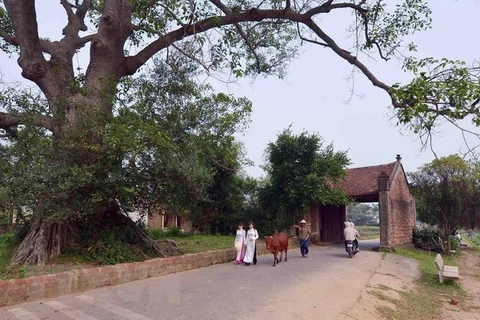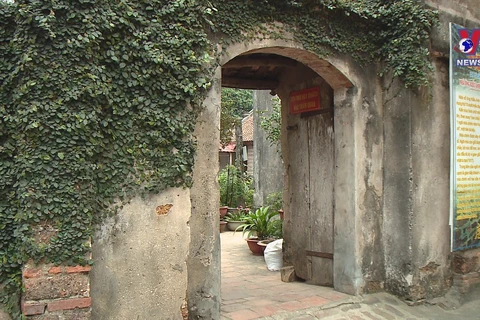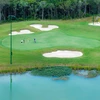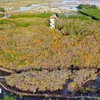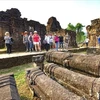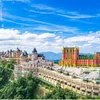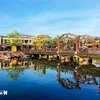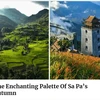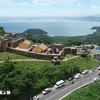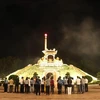 Residents in the village have always considered the row of duoi trees as the locality’s treasure. Located in Son Tay town of the same name district, about 40km west of Hanoi’s centre, Duong Lam has the typical features of a rural village with a giant banyan tree, a common fresh water well, and a communal house, along with 956 old houses dating back 100 to 400 years. Possessing an interesting cultural value and a landscape and architecture typical for a rural area in the Red River Delta, it has become a popular tourist destination. In 2006, Duong Lam became the first village that had been recognised as a national historical and cultural relic. (Photo: Vietnamplus)
Residents in the village have always considered the row of duoi trees as the locality’s treasure. Located in Son Tay town of the same name district, about 40km west of Hanoi’s centre, Duong Lam has the typical features of a rural village with a giant banyan tree, a common fresh water well, and a communal house, along with 956 old houses dating back 100 to 400 years. Possessing an interesting cultural value and a landscape and architecture typical for a rural area in the Red River Delta, it has become a popular tourist destination. In 2006, Duong Lam became the first village that had been recognised as a national historical and cultural relic. (Photo: Vietnamplus)  Legend has it that the duoi trees were the place where King Ngo Quyen (897-999) tied his war horses before leading the troops against Chinese invaders on Bach Dang River, ending a 1,000 year period when Vietnam was invaded by Chinese power. Duong Lam villagers have always guarded and protected the trees. Such tree is seen in dry lands of Asia, including the Philippines, China and India. Currently, there are only 15 duoi trees left. Earlier, three trees died of age and diseases. Over a thousand years of history, Duong Lam villagers have always guarded and protected from anyone trespassing or damaging the trees. (Photo: VietnamPlus)
Legend has it that the duoi trees were the place where King Ngo Quyen (897-999) tied his war horses before leading the troops against Chinese invaders on Bach Dang River, ending a 1,000 year period when Vietnam was invaded by Chinese power. Duong Lam villagers have always guarded and protected the trees. Such tree is seen in dry lands of Asia, including the Philippines, China and India. Currently, there are only 15 duoi trees left. Earlier, three trees died of age and diseases. Over a thousand years of history, Duong Lam villagers have always guarded and protected from anyone trespassing or damaging the trees. (Photo: VietnamPlus)  Duoi (steblus) trees are planted side by side. Their trunks are large and their height is about 6m. The canopy is luxuriant. Oval leaves with serrated edges are 3-7 cm long and about 2-3 cm wide. Tourists from Hanoi said that although they have travelled to Duong Lam many times, this is the first time they have visited the row of heritage duoi trees. Local people often stop and rest under the shade of the trees when it's sunny. The laterite-brick path along the row of trees is a "specialty" of Duong Lam ancient village. Laterites can be found almost anywhere in Duong Lam, becoming an integral part of the village. (Photo: VietnamPlus)
Duoi (steblus) trees are planted side by side. Their trunks are large and their height is about 6m. The canopy is luxuriant. Oval leaves with serrated edges are 3-7 cm long and about 2-3 cm wide. Tourists from Hanoi said that although they have travelled to Duong Lam many times, this is the first time they have visited the row of heritage duoi trees. Local people often stop and rest under the shade of the trees when it's sunny. The laterite-brick path along the row of trees is a "specialty" of Duong Lam ancient village. Laterites can be found almost anywhere in Duong Lam, becoming an integral part of the village. (Photo: VietnamPlus)  A lady in ao dai, Vietnam's traditional long dress, is walking under the canopy of the ancient duoi (steblus) trees. On weekends, this place becomes an attractive destination for tourists, especially young couples. During the COVID-19 pandemic, when outbound travels have been restricted, local tourists are looking for new destinations in the country and the row of the ancient duoi trees in Duong Lam is their choice thanks to its historical value and beauty. The row of the ancient duoi trees was recognised as heritage trees of Vietnam by the Vietnam Association for Conservation of Nature and Environment (VACNE) in April 2011. (Photo: VietnamPlus)
A lady in ao dai, Vietnam's traditional long dress, is walking under the canopy of the ancient duoi (steblus) trees. On weekends, this place becomes an attractive destination for tourists, especially young couples. During the COVID-19 pandemic, when outbound travels have been restricted, local tourists are looking for new destinations in the country and the row of the ancient duoi trees in Duong Lam is their choice thanks to its historical value and beauty. The row of the ancient duoi trees was recognised as heritage trees of Vietnam by the Vietnam Association for Conservation of Nature and Environment (VACNE) in April 2011. (Photo: VietnamPlus)  Laterites can be found almost anywhere in Duong Lam, becoming an integral part of the village. Laterites, the key material of walls, gates and wells, are abundant in Mong Phu village, lying under fields, garden ponds, or deep down underground. Laterite, both a soil and a rock type rich in iron and aluminum, is often soft underground but getting harder over time once it is dug up to build houses. Houses’ walls and fences made of rough dark honey-brown brick-shaped laterites along the village road create a unique charm. Possessing interesting cultural value and a landscape and architecture typical for a rural area in the Red River Delta, Duong Lam has long become a popular tourist destination. (Photo: VietnamPlus)
Laterites can be found almost anywhere in Duong Lam, becoming an integral part of the village. Laterites, the key material of walls, gates and wells, are abundant in Mong Phu village, lying under fields, garden ponds, or deep down underground. Laterite, both a soil and a rock type rich in iron and aluminum, is often soft underground but getting harder over time once it is dug up to build houses. Houses’ walls and fences made of rough dark honey-brown brick-shaped laterites along the village road create a unique charm. Possessing interesting cultural value and a landscape and architecture typical for a rural area in the Red River Delta, Duong Lam has long become a popular tourist destination. (Photo: VietnamPlus)  Duong Lam is dubbed as one of the oldest villages in Vietnam with a history that is said to date back more than 1,200 years. It was also the first village recognised as a national historical and cultural relic in 2005. Most of the village's traditional features survived the ravages of war, and many of its pagodas, communal halls, streets and trees give the place an authenticity that is probably unmatched elsewhere. The old Duong Lam Village is famous for its homes made of laterite, a type of red soil. Most of these houses have their own courtyards surrounded by a laterite wall. (Photo: VietnamPlus)
Duong Lam is dubbed as one of the oldest villages in Vietnam with a history that is said to date back more than 1,200 years. It was also the first village recognised as a national historical and cultural relic in 2005. Most of the village's traditional features survived the ravages of war, and many of its pagodas, communal halls, streets and trees give the place an authenticity that is probably unmatched elsewhere. The old Duong Lam Village is famous for its homes made of laterite, a type of red soil. Most of these houses have their own courtyards surrounded by a laterite wall. (Photo: VietnamPlus)  Duong Lam is called the Land of Two Kings: Phung Hung and Ngo Quyen. According to historical records, Phung Hung (761-802), famous for launching an insurrection against northern foreign invaders to win autonomy for the nation, was born in Duong Lam. When he died, people showed their deep gratitude to him and praised him as "The Great Father King". Ngo Quyen (896-944), descendant of a notable tribe in Duong Lam, defeated the Southern Han troops on the Bach Dang River in 938 and proclaimed himself the king, setting up his capital in Co Loa. Historians treat this point in time as the point of liberation from Chinese domination. (Photo: VietnamPlus)
Duong Lam is called the Land of Two Kings: Phung Hung and Ngo Quyen. According to historical records, Phung Hung (761-802), famous for launching an insurrection against northern foreign invaders to win autonomy for the nation, was born in Duong Lam. When he died, people showed their deep gratitude to him and praised him as "The Great Father King". Ngo Quyen (896-944), descendant of a notable tribe in Duong Lam, defeated the Southern Han troops on the Bach Dang River in 938 and proclaimed himself the king, setting up his capital in Co Loa. Historians treat this point in time as the point of liberation from Chinese domination. (Photo: VietnamPlus)  Duong Lam Village is said to be a living museum, vibrating in the present even as time seems to have stopped centuries ago. It is also the birthplace of many other prominent cultural and historical personalities. Confucian scholar Giang Van Minh (1573–1638) became a diplomat martyr after he was sent as an envoy to the Chinese Ming court during the reign of King Le Than Tong in 1637. For asserting the nation’s independence, he was killed. Another Confucian scholar and educator, Kieu Oanh Mau (1854-1912), a district governor, an educational inspector and teacher of the famous Dong Kinh Nghia Thuc School, was also a native of Duong Lam. (Photo: VietnamPlus)
Duong Lam Village is said to be a living museum, vibrating in the present even as time seems to have stopped centuries ago. It is also the birthplace of many other prominent cultural and historical personalities. Confucian scholar Giang Van Minh (1573–1638) became a diplomat martyr after he was sent as an envoy to the Chinese Ming court during the reign of King Le Than Tong in 1637. For asserting the nation’s independence, he was killed. Another Confucian scholar and educator, Kieu Oanh Mau (1854-1912), a district governor, an educational inspector and teacher of the famous Dong Kinh Nghia Thuc School, was also a native of Duong Lam. (Photo: VietnamPlus)  Duong Lam was the first village recognised as a national historical and cultural relic in 2005. Most of the village's traditional features survived the ravages of war, and many of its pagodas, communal halls, streets and trees give the place an authenticity that is probably unmatched elsewhere. The old Duong Lam Village is famous for its homes made of laterite, a type of red soil. Most of these houses have their own courtyards surrounded by a laterite wall. In 1972, Vietnamese archaeologists unearthed many relics at Mound Ma Dong in Duong Lam Village: axes, tables, wedges, pestles and ceramic decorative objects of all patterns. (Photo: VietnamPlus)
Duong Lam was the first village recognised as a national historical and cultural relic in 2005. Most of the village's traditional features survived the ravages of war, and many of its pagodas, communal halls, streets and trees give the place an authenticity that is probably unmatched elsewhere. The old Duong Lam Village is famous for its homes made of laterite, a type of red soil. Most of these houses have their own courtyards surrounded by a laterite wall. In 1972, Vietnamese archaeologists unearthed many relics at Mound Ma Dong in Duong Lam Village: axes, tables, wedges, pestles and ceramic decorative objects of all patterns. (Photo: VietnamPlus)  Laterites, the key material of walls, gates and wells, are abundant in Mong Phu village, lying under fields, garden ponds, or deep down underground. Laterite, both a soil and a rock type rich in iron and aluminum, is often soft underground but getting harder over time once it is dug up to build houses. Houses’ walls and fences made of rough dark honey-brown brick-shaped laterites along the village road create a unique charm. Possessing interesting cultural value and a landscape and architecture typical for a rural area in the Red River Delta, Duong Lam has long become a popular tourist destination. (Photo: VNA)
Laterites, the key material of walls, gates and wells, are abundant in Mong Phu village, lying under fields, garden ponds, or deep down underground. Laterite, both a soil and a rock type rich in iron and aluminum, is often soft underground but getting harder over time once it is dug up to build houses. Houses’ walls and fences made of rough dark honey-brown brick-shaped laterites along the village road create a unique charm. Possessing interesting cultural value and a landscape and architecture typical for a rural area in the Red River Delta, Duong Lam has long become a popular tourist destination. (Photo: VNA) VNA
